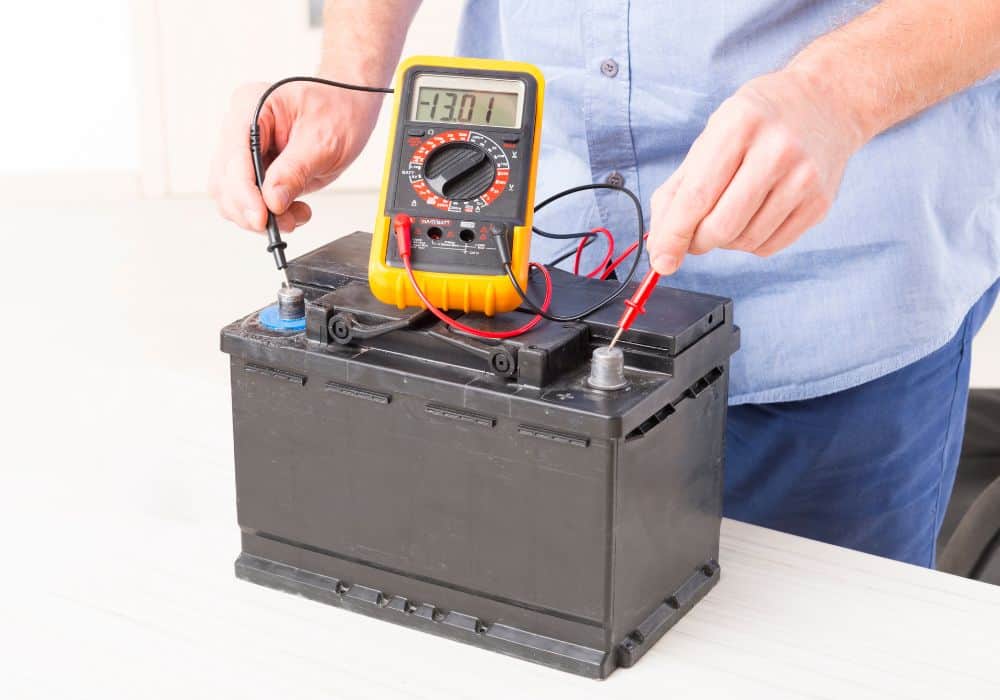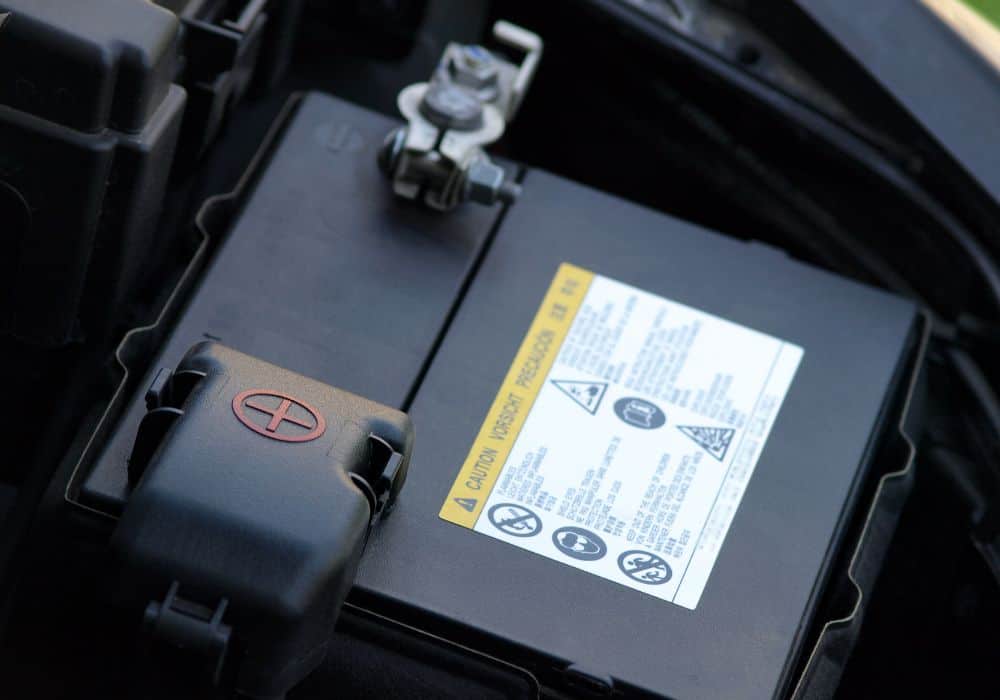Car batteries include a lot of useful information on them, but wattage is not one of them. To determine this number you use the information that they provide to calculate how many watts are in your specific car battery.
For most 12.6 volt car batteries that run 105 amps, this equals out to 1,323 watts. This number differs depending on the battery for your vehicle, so double check the information and plug it into the equation we include later in this article.
Wattage is not a clear indicator of battery capacity, and there is more information you need to understand how your battery operates and what kind of power it offers. In this article, we explain all the terms you need to know and how they factor into your battery performance.
Table of Contents
Car Battery Terms to Know
Before we get into all the math equations, let’s establish the different units of measurement that relate back to your battery: Watts, watt hours, voltage, amps and amp hours.
A common misconception is that these are all different terms for the same things relating back to battery power. These actually measure different details of your battery, and the variables depend on each other.
1. Watts and Watt-Hours
Watts (W) refers to the power of the battery. This unit relates to the flow of energy in the device at any moment in time. Higher watts equate to a greater flow of energy, while lower watts are a lower flow.
This differs from a watt-hour (Wh), which is a per-unit measurement of how much power flows over a period (how many watts flow per hour).
These appear in different variations, usually kilowatts (kW) and kilowatt-hours (kWh). This only indicates a unit of measurement (kilo meaning 1,000)
2. Voltage

While voltage is related to wattage, they are not the same. Instead of power, voltage measures the potential difference and EMF of a battery. Most cars use a 12-volt battery, meaning that the quotient of its potential energy and its charge equals that amount.
Voltage is an easier unit to measure, so it’s best to take the voltage and use that to calculate the watts in a car battery. While this number is usually listed, you can use a voltmeter to measure the nominal voltage derived from battery age and condition.
3. Amps and Ampere-Hours
Amperes are the third unit to know, and they’re often listed on your battery information. You can plug in this number to calculate the watts in a car battery.
Amps refer to the electric current of the battery, or the amount of electricity that flows through the battery. When you multiply this number by the potential (battery voltage), you get the watts of the battery.
This number changes depending on the situation, and there are no fixed Amps for your car battery. Because of this, you need to determine the Amps at any one point to accurately calculate the watts of your car battery.
An ampere-hour refers to how much energy a battery may supply for a single hour, and it serves as a measurement for capacity. A 12V battery with a capacity of 100Ah supplies 100 Amps to a 12-volt device for a single hour.
How to Calculate Watts in a Car Battery
When it comes to calculating power in an object, we refer back to Ohm’s law. This calculates the relationship between voltage (V), current (I), and resistance (R) of a circuit, defining it in amps using the equation I = V/R.
When we transpose this to calculate power (P), we can use it to calculate the watts of a car battery, the final equation looks like this:
- Power (P) = Volts (V) x Current (I)
To calculate the potential watts in a car battery, you need to locate the voltage and amps to plug into this equation:
- Watts (W) = Volts (V) x Amps (A)
You can see this work out if we plug in our average calculations:
- 105 A x 12.6 V = 1,323 W
This number varies depending on the actual details of your car battery. Nominal voltage remains the same, but effective voltages and the current of your battery vary depending on battery condition and how it runs.
How to Calculate Watt-Hours in a Car Battery

While we’re asking about how many watts there are in a car battery, using watt-hours is more appropriate to determine the battery capacity. This also plugs in more seamlessly with the information provided by batteries, as they usually include amp-hours (Ah) instead of raw amps.
The equation for this is similar to the equation for watts:
- Watt-hour (Wh) = Volts (V) x Amp-hour (Ah)
Assuming an average amp-hour rating of 40Ah, this looks like:
- 12.6 V x 40 Ah = 504 Wh
All you are doing at this point is converting your capacity unit from amp-hours to watt-hours.
How to Calculate Effective Power of a Car
You can calculate the actual power of your battery at a given moment by determining the effective volts and amps.
You can determine both units by using a multimeter.
How to Measure Battery Voltage
- Start with your battery off, and set your multimeter between 15 and 20 volts (ideal for a 12.6V battery).
- Connect your multimeter to the positive and negative battery terminals.
- Start the car, and note the revised voltage.
This provides you with the actual voltage of the battery while operating.
How to Measure Battery Amperage
- Switch your multimeter to measure amperage, and make sure you plug in your black comm led and your red probe (choose amps, not milliamperes).
- Set your measurement range higher than your expected measurement. You can always decrease this later to improve accuracy.
- Starting with your car off, connect the clips to each of the battery terminals.
- Turn the car on and note the measured amperage. Decrease your range as needed.
This provides a more accurate number than the estimated amperage of your car, and you can now plug it into the formula to determine the amount of watts (power) of the battery during operation.
Factors that Affect Car Battery Power
The power of your car battery varies depending on what’s running, but it’s also affected by details such as: the type of battery you have, smaller specifications, and environmental factors.
This is why different types of cars take different battery sizes and types, even if they both offer 12.6V and the size of the battery appears the same.
1. Type of Battery
Car batteries come in many types and use different designs to accomplish different things.
Most cars use what we call a lead-acid battery, but this still comes in two different types.
The first, known as a flooded battery or wet-cell battery, requires you to top it off. These are less expensive, but power fluctuates depending on how well you maintain the battery.
Valve Regulated Lead Acid (VRLA) batteries are more expensive but maintenance-free. They don’t need topping off, and you can expect a more consistent power.
Getting more specific, most car batteries are either AGM or deep-cycle variations.
AGM batteries are VRLA through-and-through, and they’re specifically designed to handle higher demands. They cost more than conventional batteries.
Deep cycle batteries can be flooded or sealed, and they work better for sustaining low current draw over long periods of time. While you may see them in your car, they work better than marine batteries or recreational power sources.
2. Specifications

Smaller details that tie into car battery power include your reserve capacity and cold cranking amps. While these refer to specific situations, they explain the potential power of your battery.
Reserve capacity explains how many minutes it will take a fully charged battery sitting at 80°F to discharge a current of 25 amps until the charge drops below 10.5 volts. This ensures that all the accessories under this low receive power.
The cold cranking amps (CCA) measure how many amps the battery can crank out at 0°F for 30 seconds without dropping below 7.2 volts. High CCA batteries are needed for cold weather.
3. Environmental Factors
The biggest factors that affect battery life over time include the age of the battery and the current temperature.
Batteries degrade over use and time. The more discharge cycles the battery runs through, the more its capacity drops and the lower other variables go. This is why manufacturers recommend replacing your battery every 3 to 5 years.
Furthermore, temperature affects the level of battery fluid and may damage the battery, inhibiting current and power. Those who live in hotter climates usually need to replace their batteries sooner than those in cooler temperatures.
Conclusion
Determining any detail of your car battery comes down to finding the right tool of measurement or using the right equation. Because you cannot outright measure how many watts are in your car battery, remember to use this formula:
- Watts (W) = Volts (V) x Amps (A)
With the right tools, you can learn a lot more about the state of your battery, and you might even pick up on issues before they arise.
Do you need help running through these calculations or finding this information for your battery? Comment below!
